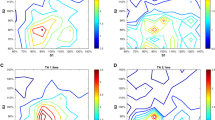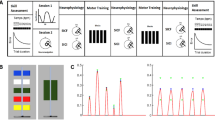Abstract
Paired-pulse transcranial magnetic stimulation was used in three experiments to measure the properties of long-latency intracortical inhibition (LICI) acting on the relaxed first dorsal interosseus muscle of the left and right hand in right-handed volunteers. The experiments show that LICI is asymmetrical: it emerges more rapidly and is greater in the dominant than non-dominant hand shortly after activation of the LICI circuits, and is greater with low-intensity conditioning stimulus intensities in the dominant than non-dominant hand. These findings suggest that asymmetrical function of long-latency inhibitory circuits in motor cortex might contribute to the asymmetrical dexterity between the hands, possibly through their inhibitory control of the circuits responsible for short-latency inhibition.



Similar content being viewed by others
References
Amunts K, Schlaug G, Schleicher A, Steinmetz H, Dabringhaus A, Roland PE, Zilles K (1996) Asymmetry in the human motor cortex and handedness. Neuroimage 4:216–222
Amunts K, Schmidt-Passos F, Schleicher A, Zilles K (1997) Postnatal development of interhemispheric asymmetry in the cytoarchitecture of human area 4. Anat Embryol 196:393–402
Buccolieri A, Abbruzzese G, Rothwell JC (2004) Relaxation from a voluntary contraction is preceded by increased excitability of motor cortical inhibitory circuits. J Physiol 558:685–695
Chen R, Lozano AM, Ashby P (1999) Mechanism of the silent period following transcranial magnetic stimulation. Evidence from epidural recordings. Exp Brain Res 128:539–542
Civardi C, Cavalli A, Naldi P, Varrasi C, Cantello R (2000) Hemispheric asymmetries of cortico-cortical connections in human hand motor areas. Clin Neurophysiol 111:624–629
Hammond G (2002) Correlates of human handedness in primary motor cortex: a review and hypothesis. Neurosci Biobehav Rev 26:285–292
Hammond G, Faulkner D, Byrnes M, Mastaglia F, Thickbroom G (2004) Transcranial magnetic stimulation reveals asymmetrical efficacy of intracortical circuits in primary motor cortex. Exp Brain Res 155:19–23
Hess A, Kunesch E, Classen J, Hoeppner J, Stefan K, Benecke R (1999) Task-dependent modulation of inhibitory actions within the primary motor cortex. Exp Brain Res 124:321–330
Kujirai T, Caramia MD, Rothwell JC, Day BL, Thompson PD, Ferbert A, Wroe S, Asselman P, Marsden CD (1993) Corticocortical inhibition in human motor cortex. J Physiol 471:501–519
Liepert J, Classen J, Cohen LG, Hallett M (1998) Task-dependent changes of intracortical inhibition. Exp Brain Res 118:421–426
Lo YL, Fook-Chong S (2005) The silent period threshold as a measure of corticospinal inhibition. J Clin Neurophysiol 22:176–179
Nakamura H, Kitagawa H, Kawaguchi Y, Tsuji H (1997) Intracortical facilitation and inhibition after transcranial magnetic stimulation in conscious humans. J Physiol 498:817–823
Oldfield R (1971) The assessment and analysis of handedness: the Edinburgh inventory. Neuropsychologia 9:97–113
Priori A, Oliviero A, Donati E, Callea L, Bertolasi L, Rothwell JC (1999) Human handedness and asymmetry of the motor cortical silent period. Exp Brain Res 128:390–396
Reynolds C, Ashby P (1999) Inhibition in the human motor cortex is reduced just before a voluntary contraction. Neurology 53:730–735
Ridding MC, Taylor JL, Rothwell JC (1995) The effect of voluntary contraction on cortico-cortical inhibition in human motor cortex. J Physiol 487:541–548
Rosenkranz K, Rothwell JC (2003) Differential effect of muscle vibration on intracortical inhibitory circuits in humans. J Physiol 551:649–660
Sanger TD, Garg RR, Chen R (2001) Interactions between two different inhibitory systems in the human motor cortex. J Physiol 530:307–317
Sohn YH, Hallett M (2004) Surround inhibition in the human motor system. Exp Brain Res 158:397–404
Stinear CM, Byblow WD (2003) Role of intracortical inhibition in selective hand muscle activation. J Neurophysiol 89:2014–2020
Tinazzi M, Farina S, Tamburin S, Facchini S, Fiaschi A, Restivo D, Berardelli A (2003) Task-dependent modulation of excitatory and inhibitory functions within the human primary motor cortex. Exp Brain Res 150:222–229
Tinazzi M, Farina S, Edwards M, Moretto G, Restivo D, Fiaschi A, Berardelli A (2005) Task-specific impairment of motor cortical excitation and inhibition in patients with writer’s cramp. Neurosci Lett 378:55–58
Valls-Solé J, Pascual-Leone A, Wassermann EM, Hallett M (1992) Human motor evoked responses to paired transcranial magnetic stimuli. Electroencephalogr Clin Neurophysiol 85:355–364
Wassermann EM, Samii A, Mercuri B, Ikoma K, Oddo D, Grill SE, Hallett M (1996) Responses to paired transcranial magnetic stimuli in resting, active, and recently activated muscles. Exp Brain Res 109:158–163
Author information
Authors and Affiliations
Corresponding author
Rights and permissions
About this article
Cite this article
Hammond, G.R., Garvey, CA. Asymmetries of long-latency intracortical inhibition in motor cortex and handedness. Exp Brain Res 172, 449–453 (2006). https://doi.org/10.1007/s00221-006-0349-2
Received:
Accepted:
Published:
Issue Date:
DOI: https://doi.org/10.1007/s00221-006-0349-2




